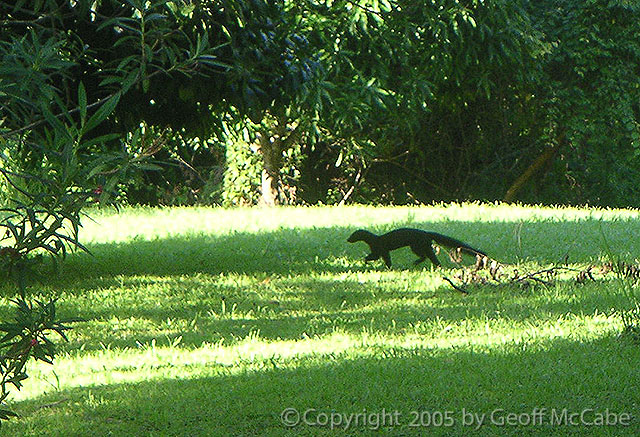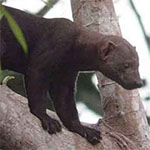
- Home
- Accommodation
- Activities
- Area Info
- Maps
- Photo Galleries
- Real Estate
- Travel
Spanish Name: Tayra
Lifespan: The average lifespan Tayra is about 18 years in captivity.
Height/Weight: Head and body length is 60 to 68 cm, with a tail 38 to 47 cm; they can weigh more than 5 kg.
Habitat: Found in tropical evergreen forests but also exist in dry deciduous forests; they live below elevations of 1,200 m.
The Tayra is a solitary mammal who prefers living in the green forests, but is generally found in dry deciduous forests. They belong to the weasel Mustelidae family, which also includes otters, skunks, and minks. They can be spotted in the dense forests and wildlife reserves in and around Monetzuma.
Tayras survive below elevations of about 1,000 feet. They can be spotted resting inside hollow trees, burrows or logs built by other animals. It can be found in the tropical jungles of southern Mexico all through South America to northern Argentina including parts of Central America like Costa Rica. Their usual habitat is in the dense woodlands of Central and South America. Tyaras can be seen in several national parks of Costa Rica including Santa Rosa National Park, Monteverde Cloud Forest Reserve, Corcovado National Park, San Vito, and La Selva.
They can also be found in the dry forests and forests close to water bodies in the Guanacaste province. They are also found in the wet lowland forests of the Caribbean region and the south Pacific slope areas. They can often be sighted on higher elevations. Visitors have a good chance of spotting them at canals of the Tortuguera National Park, La Selva Biological Field Station and Guanacaste National Parks. They are sometimes also spotted in farms and near dense plantations.
The Tayra has a black colored body with a prominent lighter patch on its chest. They have sharp claws for climbing purposes. Their tail is bushy and covered with hair. They have sharp teeth, small legs and an elongated neck. The Tayra has underdeveloped vision and they mainly rely of their sense of smell to move around.
Although Tayra’s are classified as carnivores, they are actually omnivorous and feed on rats, mice, squirrels, agoutis, and other small mammals. They also eat fruit, insects, reptiles and honeycomb. A majority of the times they will be spotted eating fruits and other parts of a plant but sometimes also catch small insects.
 They are mostly found in the mountains of Costa Rica. Tayra boasts of a 10-24 square meters of house range and travel for 3-7 kilometers in their range. Tayra sometimes hunts in groups of 20. They are extremely proficient swimmers, runners and climbers. These qualities make it very difficult for their predators to attack them. The predators will try their best to get hold of these speedy creatures and may even be led o believe that they have but the sly tayra will do attempt a quick escape at the minute and will more often than not be highly successful in fleeing. The tayra is active during the day and night.
They are mostly found in the mountains of Costa Rica. Tayra boasts of a 10-24 square meters of house range and travel for 3-7 kilometers in their range. Tayra sometimes hunts in groups of 20. They are extremely proficient swimmers, runners and climbers. These qualities make it very difficult for their predators to attack them. The predators will try their best to get hold of these speedy creatures and may even be led o believe that they have but the sly tayra will do attempt a quick escape at the minute and will more often than not be highly successful in fleeing. The tayra is active during the day and night.
The tayra’s gestation period lasts for about 63 – 70 days, following which they give birth to a litter of 2 -3 young ones. The female tyra weans for about 2-3 months. They weigh about 74 to 92 grams and though not much is known about their breeding patterns some researchers believe that the mating cycle is seasonal and births take place around March and July. Other researchers believe the tayra has monthly mating patterns and they are not seasonal breeders.
 Tayras are active cute and playful creatures and many people have them as pets. Tayra loves human company and humans are also attracted to their mischievous and playful ways. Fun as they are, these animals have a rather dangerous bite so it’s best to let them be in the wild. These creatures have wrinkles all over their face. Tayras have a very efficient communication pattern and talk in loud voices when they have to convey something within the group or to each other.
Tayras are active cute and playful creatures and many people have them as pets. Tayra loves human company and humans are also attracted to their mischievous and playful ways. Fun as they are, these animals have a rather dangerous bite so it’s best to let them be in the wild. These creatures have wrinkles all over their face. Tayras have a very efficient communication pattern and talk in loud voices when they have to convey something within the group or to each other.
The Tayra is not considered an endangered species. They can still be found in abundance all through Costa Rican forests, on the ground and even in homes as domestic pets. One quirky fact about them is that they do not make their homes themselves. Rather they live in natural places such as the hollows found in some trees created by other animals.
Tayras living in Costa Rica display a rather fascinating behavior. It picks up raw plantains that cannot be eaten and store them in a particular place while diligently returning for it at a later date when it becomes ripe and soft. They are the only animals who display this food hoarding behavior.
Tayras of Costa Rica – CostaricaJourneys.com article on Tayras
http://costarica.com/wildlife/tayras/
http://www.liveworldsnews.com/whats-a-weasel-and-lives-in-costa-rica-tayra/
http://costaricabedfinder.com/articles/125/the-tayra-of-costa-rica
My new favorite restaurant, Clandestina is not to be missed by food lovers staying anywhere near to Montezuma. Established in March 2015, Clandestina is the new kid on the block. The Oregon/Tico collaboration is a winner among locals and travelers alike, with artisan craft beers, made onsite by Butterfly Brewing Co. and delicious, exciting […]